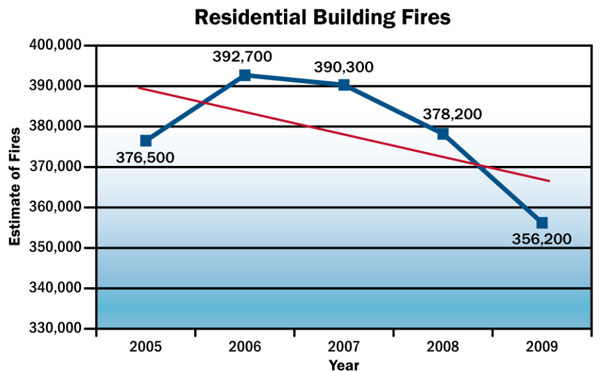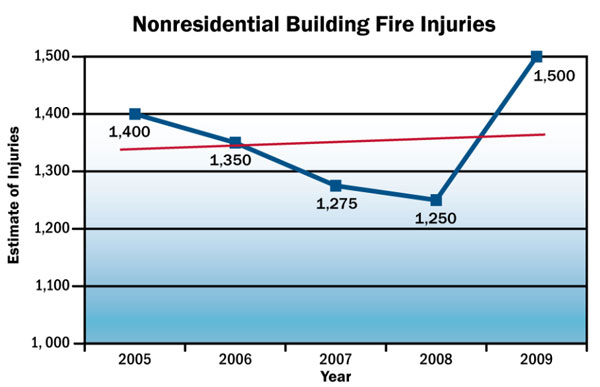How Much More Money Does A Fire Chief Make With A Bachelor Degree
Average Salary With a Fire Science Degree
Firefighters have a wide range of options for salary compensation, depending upon didactics, experience, and task location. About firefighters have a high school diploma, and entry-level positions tin start with volunteerism — especially in small towns or rural areas. For a serious expect at a fire-fighting career, an private needs to learn at least an associate'south degree in fire science and piece of work for a company that pays its employees, mostly in urban areas, as job location has an impact on your potential salary.
Firefighters are in demand, and while the number of residential fires are down, the number of nonresidential fires have increased:


Paid firefighters held about 310,400 jobs in 2008, which means that, in 2009, at that place were more residential fires than at that place were firefighters. That number did non include volunteers, however, and volunteers often make upward a large portion of rural and small-scale town fire companies. Still, the need for firefighters is increasing as populations increase.
Base Salaries for Paid Firefighters
Fire fighting is strenuous and tiresome work, as employees or volunteers often live at burn down stations during shifts and must keep equipment clean and functional. Between alarms, firefighters do skills and may perform fire inspections. A work calendar week often consists of 50 hours, and shifts often can be longer and more varied than the hours of workers in other occupations.
Volunteers also spend some time in grooming to learn how to handle equipment, how to extinguish fires, and how to manage medical emergencies. The threat of coming in contact with hazardous materials requires the use of heavy protective gear, and so burn down fighters too must be fit enough to wear this equipment and remain agile.
The paid employee'due south average hourly salary in 2008 was $21.97; notwithstanding, supervisors and managers earned approximately $34.07 per 60 minutes, and fire inspectors earned an average of $26.37 per hour. Other jobs within this occupation include burn jumpers, fire marshals and burn down investigators. These jobs require special grooming, and people who acquire these jobs often work for metropolitan areas.
Benefits can compensate for some salaries. Many firefighters, including volunteers, may receive:
- Medical and liability insurance
- Vacation and sick leave
- Some paid holidays
- Overtime pay
- Protective clothing
- Equipment
- Dress Uniforms
Firefighters generally are covered by pension plans, often offering retirement at one-half pay later 25 years of service or if the individual is disabled in the line of duty. According to the U.S. Fire Administration:
- An estimated 81,070 firefighter injuries occur annually in the United states.
- 49 percent of firefighter injuries occur on the burn down ground and six percent occur while responding to or returning from a fire incident.
- Overexertion/strain is the leading crusade of fire-related fire-eater injuries at 25 percent.
- 38 pct of all burn-related injuries outcome in lost work time.
- The majority of fire-related injuries (87 percentage) occur in construction fires.
- On boilerplate, structure fires have more injuries per fire than nonstructural fires.
- Fires causing injuries are more prevalent in July (10 percentage) and height betwixt the hours of 2 and five p.m.
While firefighting is hazardous work, people usually use for these jobs to protect their communities and out of a desire to help others. Often, firefighters come up from families of people who have served in this profession. Simply, there is no need to kickoff on the bottom floor. Educational activity frequently serves as a springboard to assistance entry-level graduates achieve leadership status.
Teaching Affects Salaries
Nigh experienced firefighters continue studying to improve their job functioning and ready for promotion examinations throughout their careers. Opportunities for promotion depend upon the results of written exams, as well as job performance, interviews, and seniority. To move upwards to positions college than battalion chief, many burn departments at present require a bachelor's degree, preferably in fire science, public assistants, or a related field. An associate's degree is required for executive fire officeholder certification from the National Burn down Academy (NFA).
An instruction in fire science increases the chance that entry-level positions will pay more and that the graduate can move into higher-level positions. An associate'southward degree in fire science can open chances to work with a fire company in larger cities, where salaried positions are more than mutual.
Entry-level employees in big fire departments are trained for several weeks at a department's grooming center or academy. Recruits written report firefighting techniques, burn prevention, hazardous materials control, local building codes, and emergency medical procedures, including starting time aid and cardiopulmonary resuscitation (CPR). They also acquire how to use a department's equipment. Subsequently they successfully complete their training, they are assigned to a fire visitor during a probationary period.
Many burn down departments accept accredited apprenticeship programs lasting up to 4 years, including programs in fighting forest fires. These programs combine formal didactics with on-the-job training under the supervision of experienced fire fighters.
One way to advance in this field is to take advantage of the training equally a certified emergency medical technician (EMT). Most all departments crave that their firefighters accept this preparation, even if at the lowest level of certification. But, farther pedagogy in EMT and paramedic grooming tin can provide entry-level admission into larger fire departments in metropolitan areas, where salaries tin compensate for that education.
Some attend training sessions sponsored by the NFA that encompass topics such equally executive development, anti-arson techniques, disaster preparedness, chancy materials control, and public fire safety education. Some fire departments offer incentives such as tuition reimbursement or higher pay for completing avant-garde grooming. Students can also obtain some didactics through altitude learning at NFA.
Working Upward the Fire Scientific discipline Ladder
There were about 365,600 paid positions in this field in 2008; firefighters held almost 310,400 jobs, and commencement-line supervisors and managers held about 55,200 jobs. These employment figures do not include volunteer firefighters, who perform the same duties and may constitute the majority of firefighters in a residential surface area. According to the U.S. Fire Assistants, about 70 pct of burn down companies were staffed entirely by volunteers in 2007.
Employment in this occupation is expected to grow by xix per centum by 2018, which is faster than the average for all occupations. Nigh job growth will stem from volunteer firefighting positions being converted to paid positions. In recent years, information technology has go more hard for volunteer fire departments to recruit and retain volunteers, peradventure because of the considerable amount of training and time commitment required.
Getting in on the ground floor and working up the hierarchical ladder is imperative for whatever worker who wants to make firefighting a career. According to the International City-County Management Association, average salaries in 2008 for sworn total-time positions were every bit follows:
- Fire chief: $78,672 to $104,780
- Deputy chief: $69,166 to $88,571
- Battalion chief: $66,851 to $81,710
- Assistant fire primary: $65,691 to $83,748
- Fire captain: $60,605 to $72,716
- Fire lieutenant: $50,464 t0 $threescore,772
- Engineer: $48,307 to $62,265
The bureaucracy structure, which culminates in the fire chief's position, can vary from section to department; however, the NFA is working to assistance states consolidate fire departments to increase fire visitor size and to assist with consequent training nationwide. Educational activity counts…every bit burn chiefs and their deputies oft have bachelor's degrees in burn science.
Location is Everything in This Occupation
Currently, a firefighter tin can find higher salaries in cities rather than in rural regions considering of the demand for more fire protection in more populated areas. Additionally, larger cities seek experienced individuals who are experts in fire equally well every bit in hazardous materials and in any first-responder skills. Emergency direction requires more knowledge than how to put out a fire or decrease the chances for a fire; educated showtime responders too know how to treat emergency situations from terrorism to tidal waves.
Becoming a firefighter affords many opportunities for advancement. A combination of experience and educational activity is typically required to motion alee in this field. While passion to help the public may outweigh the budgetary concerns, a little planning could lead to a comfortable lifestyle along with a task that fulfills a dedication to this field.
Source: http://www.firesciencedegree.com/average-salary-with-a-fire-science-degree/
Posted by: campbellyeard1966.blogspot.com

0 Response to "How Much More Money Does A Fire Chief Make With A Bachelor Degree"
Post a Comment